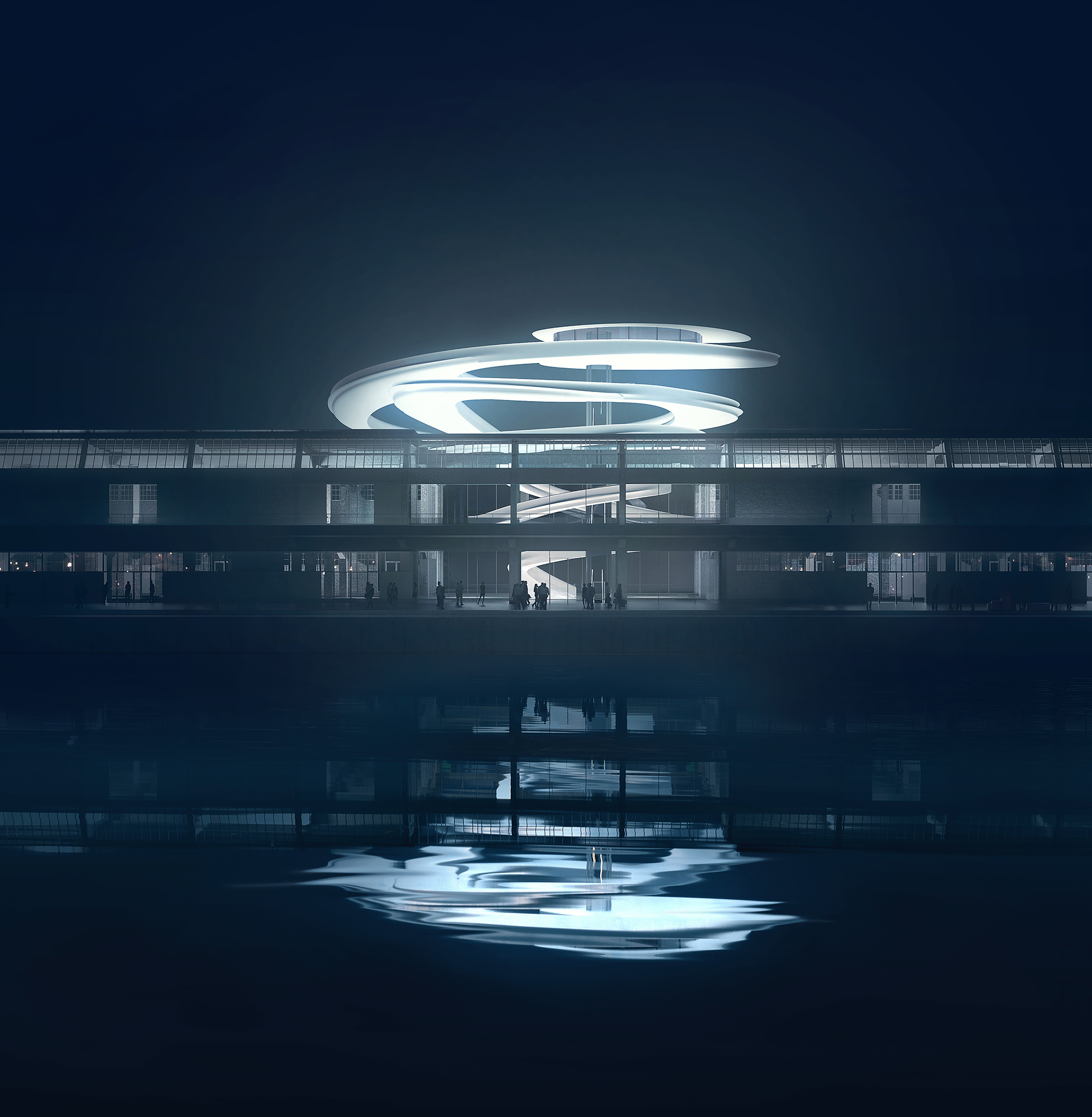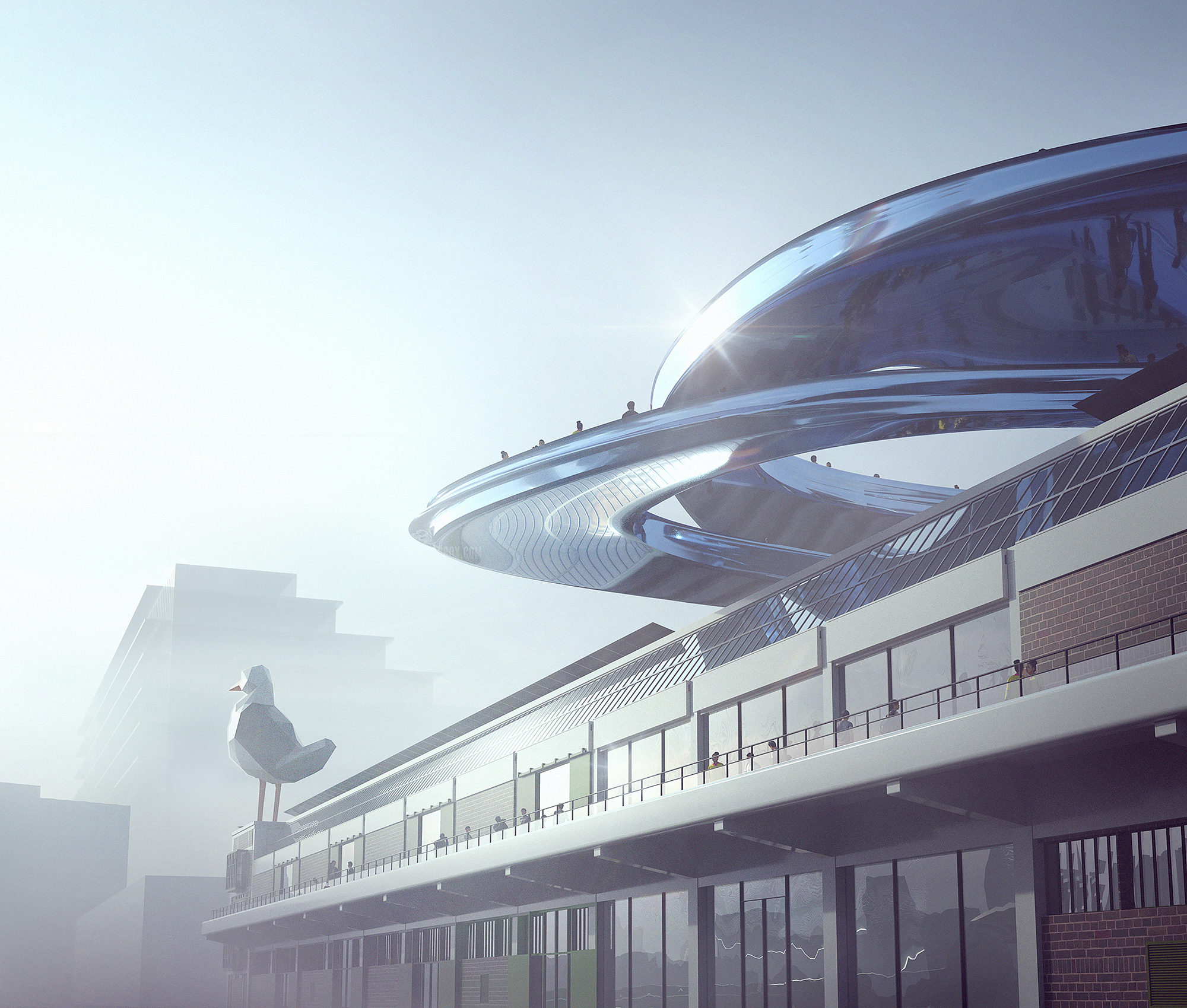MAD unveils plans for Fenix, Rotterdam’s newest cultural foundation

The Droom en Daad (Dream and Do) Foundation has announced that MAD Architects has been commissioned to create its flagship Fenix project in Rotterdam; a spiraling staircase that pierces the roof of a historic warehouse to form an observation deck. Under the artistic vision of director Wim Pijbes, the former general director of the Rijksmuseum and founding director of Museum Voorlinden, the Fenix is one of the first initiatives of the city-based philanthropic art and culture foundation. Built in 1923 by the Dutch architect C N van Goor, the Fenix warehouses in the historical Katendrecht borough are contained in an enormous concrete building, once used for the storage and transhipment of a variety of commodities, but ruined during Second World War.
‘We chose MAD directly, not via a competition, because we preferred to start a relationship from the very beginning,’ says Pijbes of the commission. In the 1900s, the Katendrecht peninsula, on the southern banks of the port of Rotterdam was one of the oldest Chinatowns in Europe; by appointing Beijing-founded firm MAD, this forgotten part of history will be revived. ‘Contrary to the current nondescript, international, could-be-anywhere modern architectural style where most buildings are rectangular and with a high-rise shiny facade, I wanted something rounded, organic or even feminine,’ adds Pijbes.

A strong, curvaceous design makes the renovated building feel eye-catching, yet softer and more organic
The futuristic, organic and sinuous design proposal certainly promises to soften Rotterdam’s rough and heavy industrial skyline. Yansong Ma, principal founder of MAD Architects explains its concept: ‘We have designed a 360-degree panoramic viewing platform on top of the warehouse as well as a staircase and ramp that connects from the ground floor to the rooftop observation deck. From a distance, the platform and staircase look like a single entity, but when it's in front of you, it stands as a sculptural work that invites you to explore. It both signifies the Fenix's witnessing of Europe's history of migration from the port and symbolises the future of the city.’
The design is intended as a metaphor for hope and a new perspective. ‘We want to give the visitor a dramatic viewpoint on the river, to evoke the feeling of getting aboard a ship that brings you to the other side of the ocean to start a new life,’ Pijbes explains.
The Fenix will be the first cultural building in Europe designed by a Chinese architectural studio, say the organisers. MAD is one of the few practising in the West – from its 2012 Absolute Towers in Toronto to the more recent Lucas Museum of Narrative Art in Los Angeles. ‘The West has been regarded as a role model by the rest of the world since the Industrial Age. There is no doubt that it is advanced in many aspects: technology, design and lifestyle. Hence, there have not been many firms from the East, especially from China, who have practised there,’ he says. ‘Now, we want to bring our Eastern design philosophy – the correlation between humans and nature – to Rotterdam.’
When completed, the Fenix will portray the stories of the docks’ millions of migrants through an art collection on the topic of ‘movement’. The ground floor of the warehouse will offer creative, culinary and cultural activities.

With this commission, MAD becomes the first practice from its country to design a prominent cultural building in Europe, the studio says

At the heart of the design sits a striking spiral circulation hub

The project sits in the city's historical borough of Katendrecht
INFORMATION
For more information visit MAD Architects website
Wallpaper* Newsletter
Receive our daily digest of inspiration, escapism and design stories from around the world direct to your inbox.
Yoko Choy is the China editor at Wallpaper* magazine, where she has contributed for over a decade. Her work has also been featured in numerous Chinese and international publications. As a creative and communications consultant, Yoko has worked with renowned institutions such as Art Basel and Beijing Design Week, as well as brands such as Hermès and Assouline. With dual bases in Hong Kong and Amsterdam, Yoko is an active participant in design awards judging panels and conferences, where she shares her mission of promoting cross-cultural exchange and translating insights from both the Eastern and Western worlds into a common creative language. Yoko is currently working on several exciting projects, including a sustainable lifestyle concept and a book on Chinese contemporary design.
-
 Japan in Milan! See the highlights of Japanese design at Milan Design Week 2025
Japan in Milan! See the highlights of Japanese design at Milan Design Week 2025At Milan Design Week 2025 Japanese craftsmanship was a front runner with an array of projects in the spotlight. Here are some of our highlights
By Danielle Demetriou
-
 Tour the best contemporary tea houses around the world
Tour the best contemporary tea houses around the worldCelebrate the world’s most unique tea houses, from Melbourne to Stockholm, with a new book by Wallpaper’s Léa Teuscher
By Léa Teuscher
-
 ‘Humour is foundational’: artist Ella Kruglyanskaya on painting as a ‘highly questionable’ pursuit
‘Humour is foundational’: artist Ella Kruglyanskaya on painting as a ‘highly questionable’ pursuitElla Kruglyanskaya’s exhibition, ‘Shadows’ at Thomas Dane Gallery, is the first in a series of three this year, with openings in Basel and New York to follow
By Hannah Silver
-
 A Xingfa cement factory’s reimagining breathes new life into an abandoned industrial site
A Xingfa cement factory’s reimagining breathes new life into an abandoned industrial siteWe tour the Xingfa cement factory in China, where a redesign by landscape architecture firm SWA completely transforms an old industrial site into a lush park
By Daven Wu
-
 Bold, geometric minimalism rules at Toteme’s new store by Herzog & de Meuron in China
Bold, geometric minimalism rules at Toteme’s new store by Herzog & de Meuron in ChinaToteme launches a bold, monochromatic new store in Beijing – the brand’s first in China – created by Swiss architecture masters Herzog & de Meuron
By Ellie Stathaki
-
 The upcoming Zaha Hadid Architects projects set to transform the horizon
The upcoming Zaha Hadid Architects projects set to transform the horizonA peek at Zaha Hadid Architects’ future projects, which will comprise some of the most innovative and intriguing structures in the world
By Anna Solomon
-
 Portlantis is a new Rotterdam visitor centre connecting guests with its rich maritime spirit
Portlantis is a new Rotterdam visitor centre connecting guests with its rich maritime spiritRotterdam visitor centre Portlantis is an immersive experience exploring the rich history of Europe’s largest port; we preview what the building has to offer and the story behind its playfully stacked design
By Tianna Williams
-
 Liu Jiakun wins 2025 Pritzker Architecture Prize: explore the Chinese architect's work
Liu Jiakun wins 2025 Pritzker Architecture Prize: explore the Chinese architect's workLiu Jiakun, 2025 Pritzker Architecture Prize Laureate, is celebrated for his 'deep coherence', quality and transcendent architecture
By Ellie Stathaki
-
 Zaha Hadid Architects reveals plans for a futuristic project in Shaoxing, China
Zaha Hadid Architects reveals plans for a futuristic project in Shaoxing, ChinaThe cultural and arts centre looks breathtakingly modern, but takes cues from the ancient history of Shaoxing
By Anna Solomon
-
 The Hengqin Culture and Art Complex is China’s newest cultural megastructure
The Hengqin Culture and Art Complex is China’s newest cultural megastructureAtelier Apeiron’s Hengqin Culture and Art Complex strides across its waterside site on vast arches, bringing a host of facilities and public spaces to one of China’s most rapidly urbanising areas
By Jonathan Bell
-
 The World Monuments Fund has announced its 2025 Watch – here are some of the endangered sites on the list
The World Monuments Fund has announced its 2025 Watch – here are some of the endangered sites on the listEvery two years, the World Monuments Fund creates a list of 25 monuments of global significance deemed most in need of restoration. From a modernist icon in Angola to the cultural wreckage of Gaza, these are the heritage sites highlighted
By Anna Solomon